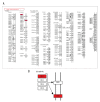Molecular Mechanisms Underlying Intestinal Ischemia/Reperfusion Injury: Bioinformatics Analysis and In Vivo Validation
- PMID: 33290384
- PMCID: PMC7733309
- DOI: 10.12659/MSM.927476
Molecular Mechanisms Underlying Intestinal Ischemia/Reperfusion Injury: Bioinformatics Analysis and In Vivo Validation
Abstract
BACKGROUND Intestinal ischemia/reperfusion (I/R) injury is a serious clinical complication. This study aimed to explore the hub genes and pathways of intestinal I/R injury. MATERIAL AND METHODS GSE96733 from the GEO website was extracted to analyze the differentially expressed genes (DEGs) of intestinal I/R injured and sham-operated mice at 3 h and 6 h after surgery. The DAVID and STRING databases were used to construct functional enrichment analyses of DEGs and the protein-protein interaction (PPI) network. In Cytoscape software, cytoHubba was used to identify hub genes, and MCODE was used for module analysis. Testing by qRT-PCR detected the expression of hub genes in intestinal I/R injury. Western blot analysis detected the key proteins involved with the important pathways of intestinal I/R injury. RESULTS IL-6, IL-10, CXCL1, CXCL2, and IL-1ß were identified as critical upregulated genes, while IRF7, IFIT3, IFIT1, Herc6, and Oasl2 were identified as hub genes among the downregulated genes. The qRT-PCR testing showed the expression of critical upregulated genes was significantly increased in intestinal I/R injury (P<0.05), while the expression of hub downregulated genes was notably reduced (P<0.05). The proteins of CXCL1 and CXCR2 were upregulated following intestinal I/R injury (P<0.05) and the CXCL1/CXCR2 axis was involved with intestinal I/R injury. CONCLUSIONS The results of the present study identified IL-6, IL-10, CXCL1, CXCL2, IL-1ß, IRF7, IFIT3, IFIT1, Herc6, and Oasl2 as hub genes in intestinal I/R injury and identified the involvement of the CXCL1/CXCR2 axis in intestinal I/R injury.
Conflict of interest statement
None.
Figures












Similar articles
-
Identification of Hub Genes and Pathways in a Rat Model of Renal Ischemia-Reperfusion Injury Using Bioinformatics Analysis of the Gene Expression Omnibus (GEO) Dataset and Integration of Gene Expression Profiles.Med Sci Monit. 2019 Nov 8;25:8403-8411. doi: 10.12659/MSM.920364. Med Sci Monit. 2019. PMID: 31699960 Free PMC article.
-
Identification and functional analysis of differentially expressed genes associated with cerebral ischemia/reperfusion injury through bioinformatics methods.Mol Med Rep. 2018 Aug;18(2):1513-1523. doi: 10.3892/mmr.2018.9135. Epub 2018 Jun 6. Mol Med Rep. 2018. PMID: 29901134 Free PMC article.
-
Bioinformatics Analysis of Differentially Expressed Genes and Protein-Protein Interaction Networks Associated with Functional Pathways in Ulcerative Colitis.Med Sci Monit. 2021 Jan 19;27:e927917. doi: 10.12659/MSM.927917. Med Sci Monit. 2021. PMID: 33462173 Free PMC article.
-
Bioinformatics Identification and Validation of Angiogenesis-Related Genes in Myocardial Ischemic Reperfusion Injury.Front Biosci (Landmark Ed). 2024 Sep 29;29(10):347. doi: 10.31083/j.fbl2910347. Front Biosci (Landmark Ed). 2024. PMID: 39473404
-
Differentially expressed genes induced by β-caryophyllene in a rat model of cerebral ischemia-reperfusion injury.Life Sci. 2021 May 15;273:119293. doi: 10.1016/j.lfs.2021.119293. Epub 2021 Mar 8. Life Sci. 2021. PMID: 33705733
Cited by
-
Exosomes derived from bone marrow mesenchymal stem cells regulate pyroptosis via the miR-143-3p/myeloid differentiation factor 88 axis to ameliorate intestinal ischemia-reperfusion injury.Bioengineered. 2023 Dec;14(1):2253414. doi: 10.1080/21655979.2023.2253414. Bioengineered. 2023. PMID: 37674357 Free PMC article.
-
Acute stress transiently activates macrophages and chemokines in cervical lymph nodes.Immunol Res. 2024 Apr;72(2):212-224. doi: 10.1007/s12026-023-09409-w. Epub 2024 Feb 14. Immunol Res. 2024. PMID: 38351242 Free PMC article.
-
Protective effect of ghrelin on intestinal I/R injury in rats.Open Med (Wars). 2022 Jul 20;17(1):1308-1317. doi: 10.1515/med-2022-0520. eCollection 2022. Open Med (Wars). 2022. PMID: 35937002 Free PMC article.
-
Potentially Functional microRNA-mRNA Regulatory Networks in Intestinal Ischemia-Reperfusion Injury: A Bioinformatics Analysis.J Inflamm Res. 2021 Sep 21;14:4817-4825. doi: 10.2147/JIR.S328732. eCollection 2021. J Inflamm Res. 2021. PMID: 34584440 Free PMC article.
References
-
- Corcos O, Nuzzo A. Gastro-intestinal vascular emergencies. Best Pract Res Clinl Gastroenterol. 2013;27(5):709–25. - PubMed
-
- Meszaros AT, Buki T, Fazekas B, et al. Inhalation of methane preserves the epithelial barrier during ischemia and reperfusion in the rat small intestine. Surgery. 2017;161(6):1696–709. - PubMed
-
- Oldenburg WA, Lau LL, Rodenberg TJ, et al. Acute mesenteric ischemia – A clinical review. Arch Intern Med. 2004;164(10):1054–62. - PubMed
MeSH terms
Substances
LinkOut - more resources
Full Text Sources
Research Materials

